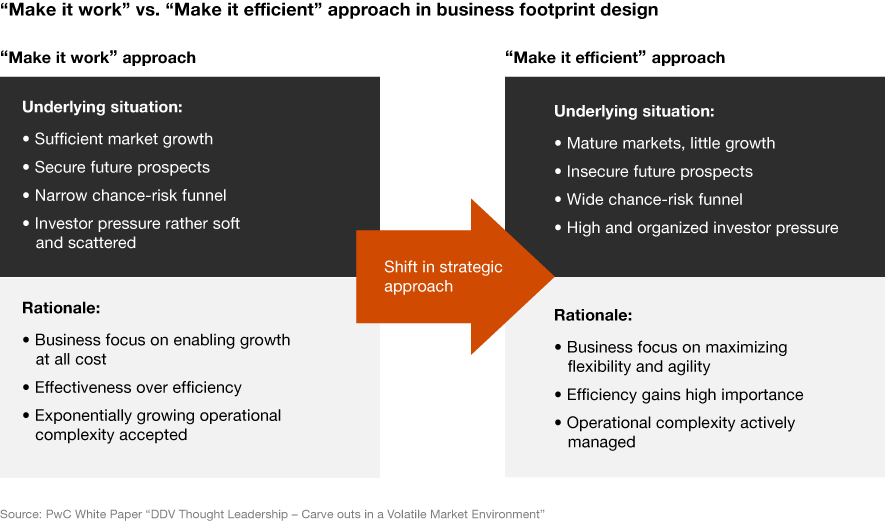
How to successfully manage carve-outs in a volatile market environment
04 December, 2019
Conditions for mergers and acquisitions have been very favorable over the last years, and the market has been quite competitive. This was true for both sellers and buyers, who have had access to cheap and plenty financing opportunities. Furthermore, the general market environment has been favorable - with stable growth rates, adequate profitability, and clear planning parameters.
However, prospects for the future have become more insecure and volatile lately as we are seeing signs of a possible economic downturn. Geopolitical events such as Brexit and the trade conflict between China and the US create uncertainty in the market. At the same time, it is getting more difficult to realize substantial growth while activist investors increase the pressure on optimizing profitability. Sellers are therefore required to manage their portfolio in a more active, flexible and agile way in order to maximize the return on their capital employed and optimize their overall risk profile. Carve-outs are an important strategic tool to achieve this. The PwC White Paper (download link below) illustrates how to successfully manage carve-outs in the current market environment.
“Technological trends such as Artificial Intelligence (AI) or Big Data increase the pressure on companies to develop or acquire ground-breaking innovations. In that context, companies need to have a clear understanding of what they consider to be their core business, and which parts of the business may be suitable for selling in order to free-up capital to invest in future trends.”

Carve-outs as a strategic tool
These considerations led to a carve-out and separation frenzy over the last years. Carve-outs have been gaining more relevance as a strategic tool to better match the competitive positioning and corporate portfolio with the corporate strategy goals. Beyond that, the underlying rationale for carve-outs varies and serves many other strategic purposes, ranging from divestitures under pressure to improve liquidity, reducing the debt burden, or improving the overall risk profile, maximizing market value via “de-conglomerization”, or simply reacting to regulatory burdens.
„To effectively make use of carve-outs in the current challenging market environment, companies have to develop a detailed understanding of their own portfolio and become clear whether their offerings and market positioning still match their strategic goals “, stresses Samy Walleyo.
Does it fit from a strategic perspective?
Firstly, a constant validation and adaptation of the corporate strategy is required to make it optimally fit the dynamic needs of global markets. Secondly, it is paramount to operationalize the corporate strategy across the key dimensions product, customer, technology, and region, and to evaluate how these dimensions contribute to achieving the strategic goals. By constantly assessing the existing portfolio against strategy, companies can divide their core business from non-core business. That distinction allows them to tailor the organic and inorganic corporate development measures to shape the corporate portfolio.
“We recommend business leaders to assess at least yearly whether their corporate portfolio still matches their strategy adequately and to adapt strategic measures accordingly. At the same time, companies need to develop a deep understanding of their operational entanglements so that they can carry out strategic measures such as carve-outs as fast and efficient as possible with a clear focus on value maximization.”
Understanding Operational Entanglements
Once a solid strategic fit assessment has been conducted, strategic measures defined and the decision which parts of the business should be carved-out is made, focus needs to shift to the HOW. Businesses are faced with the challenge of understanding the complexity as well as the extent of operational dependencies and entanglements. It is no longer enough to simply “make it work”, says Samy Walleyo. Instead, businesses need to develop a “make it efficient” approach to realize operational efficiency potentials.
When assessing the operational entanglements, companies are well advised to follow the methodology that PwC has developed and successfully used for years. It runs along the three dimensions “functions”, “processes” and “entities”. “Actively managing these operational entanglements results in shortened lead times to deliver transactions, such as divesting a business unit which was no longer considered core. At the same time, the approach enables businesses to increase their general agility and flexibility for transactions and to realize enormous operational efficiencies even apart from transactions”, according to Samy Walleyo.

PwC supports clients with the “Exit Readiness Accelerator”
PwC’s deal experts support businesses in analyzing and managing operational dependencies and entanglements. This helps to divest parts of a business quickly and successfully with a clear value focus; yet also apart from transactions to make businesses more efficient, agile and competitive.
PwC has developed a tool-aided methodology, the “Exit Readiness Accelerator”. The tool helps businesses to identify and understand operational entanglements and how to be resolve these in the context of an envisaged carve-out. Thereby the tool supports top management teams to maximize transaction success and thus allows them to quickly shift their focus back to strengthening their core business with full force.











